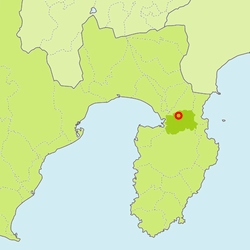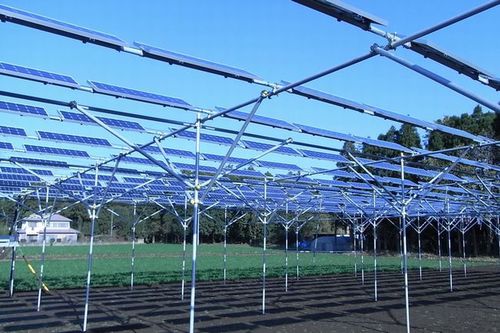August 15, 2014
Solar Sharing in Japan: Efforts and Hurdles
Keywords: Environmental Technology Renewable Energy
Since Japan introduced its feed-in-tariff (FIT) scheme in 2012, the installation of photovoltaic (PV) power generation systems has advanced across the country. Among renewable energy technologies, PV systems are one of quickest and easiest systems to install. Since most areas in Japan that are suitable for large-scale solar power plants are, according to some reports, already utilized or being planned for use, installers are starting to look for other places to set these systems. One idea is solar sharing, a method of generating electricity on farmland using solar panels mounted to a raised framework, with crops growing underneath. Below we share a story from a company that worked on developing a solar sharing project.
Editor's Note: This article is reproduced in edited form with permission from Smart Japan. Smart Japan is an online media specialized in energy conservation, storage and generation.
-------------------------
"I was completely unaware of all of the hidden problems until I started accepting solar sharing orders," says Yoshihiro Iwahori, president of Hatsudenman Co., a company operating in the design, construction, and distribution of PV systems. Hatsudenman now accepts orders for the design and construction of solar sharing projects, a task that involves installing solar panels at regular, spaced intervals above farm crops. In essence, solar sharing is a land sharing system between agriculture and electricity generation.
To install the solar panels, several poles are erected and frames for holding the PV modules are attached horizontally to the poles. Unlike large-scale systems, which seek to maximize generation capacity per area, solar sharing systems require empty space between the modules to allow sunlight to pass through and reach the ground.
Solar sharing was developed in Japan by a machinery engineer who was interested in both farming and solar power generation. At the time, there were no commercially available materials for building a solar sharing system, so the first systems were all designed and assembled from scratch.
The Agricultural Land Act, which required procedures for temporary conversion of farmland for non-agricultural purposes, also posed a major restriction to the spread of solar sharing. Guidelines defining the conditions that would allow for a temporary conversion for solar power generation were nonexistent. In response, the Ministry of Agriculture, Forestry and Fisheries issued guidelines in March 2013, triggering a sharp rise in the number of farmers undertaking solar sharing. Yet three hurdles remained that made solar sharing projects difficult: the lack of an agricultural committee for granting permission for farmland conversion, materials suitable for building solar sharing systems, and financing for farmers.
Currently, farmland conversions are approved by the agricultural committee in each region. Iwahori says, "It was a tough negotiation because not every committee understands the ministry's guidelines." It took Iwahori almost three months to complete negotiations with the agricultural committee in Shizuoka Prefecture.
The second hurdle is related to the solar cell module. According to Iwahori, solar cell modules for solar sharing need to be lightweight, as they are installed in high locations. They also need to be small to reduce the influence of shadows cast by the modules themselves and wind hitting the modules. As the output of modules for home use has been increasing, larger modules with an output of about 200 watts are diffused. Although we need an output of about 100 watts, major manufacturers have not marketed modules with suitable size and output for solar sharing. Therefore, we ordered custom modules directly from a manufacturer.

Iwahori's first solar sharing project was for a farm with a rice paddy and vegetable field in Nagoya, Izunokuni City, Shizuoka Prefecture, where he adopted the "Sorakaru-system," a manual turner for solar cell modules. According to Iwahori, it was the first project to turn modules by hand in rice paddies in Japan.
The Sorakaru-system consists of a horizontal tube and a mechanism to hold the tube and turn the tube using a winch. With this system, one can adjust the volume of light according to type of crop and turn the modules for each season, thus increasing power generation by about 5 percent. It also has features that avoid strong winds and snow coverage, and allow easy cleaning.
In the Smart Life Solar Power Generation Plant completed in June 2014, paddies and vegetable fields lie side-by-side. Rice is cultivated in the paddies and dasheen is grown in the fields. Dasheen is an obligate shade plant that dislikes intense light from seedling until harvest, which makes it well suited to solar sharing.
Installed above the 1,000-square-meter paddies and fields, the system produces 44 kilowatts each (88 kilowatts in total). Eight power conditioner units that can handle 5.5 kilowatts electricity are installed on the side of each stand. All of the generated electricity is sold to Tokyo Electric Power Company through the renewable energy FIT scheme, with an expected income of 4 million yen (about US$ 38,800) in a year.
When adopting the Sorakaru-system, the initial costs are 15 to 17 million yen (about US$ 146,000- 165,000) for parts and construction (excluding tax and land improvement costs) to build a 50-kilowatt solar sharing power generation plant.
The solar sharing system is constructed directly on farmlands. According to Iwahori, tubes are embedded about 60 centimeters into a concrete foundation of 70 centimeters in depth and 20 to 30 centimeters in diameter for the both paddies and fields. This construction process requires approval for the temporal conversion of farmlands.
Farmers can easily continue farming with the system constructed by Hatsudenman, because adequate space is secured to operate tractors and other modern farming equipment.
Source: Smart Japan (in Japanese)
Related
"JFS Newsletter"
- 'Yumekaze' Wind Turbine Project Connects Metro Consumers and Regional Producers: Seikatsu Club Consumers' Co-operative
- Shaping Japan's Energy toward 2050 Participating in the Round Table for Studying Energy Situations
- Nishiawakura's Initiative for 100% Energy Self-Sufficiency, and a Municipal ICO Scheme
- Actions Toward 100% Renewable Energy in Japan
- Sustainable Community Building in Shimokawa: Recycling-Oriented Forest Management Enabling Permanent Use of Forest Resources
Related
"Popular Articles"
- Current Status of Renewable Energy in Japan (2015)
- Offshore Wind Farm Withstands Great East Japan Earthquake and Tsunami
- Current Status of Renewable Energy in Japan (2014)
- Geothermal Power: Japan Has World's Third Largest Geothermal Reserves, 60 Percent of Which Can Be Developed
- Tokyo Plans to Increase Renewable Energy Ratio to 20% by 2024



